The Drop Is Coming And It Could Be Epic
Some things have been troubling me about the stock market lately. A growing number of coronavirus cases are leading to increased restrictions and lockdowns in numerous countries. This phenomenon is contributing to a slowdown in economic growth across multiple essential economies. In addition, the Fed taper is coming, and markets anticipate the central bank will begin hiking interest rates soon. On top of all this, the S&P 500's (SPX) technical image is deteriorating. Unfortunately, these detrimental factors are converging while stock valuations are running wild, and we are looking at one of the most expensive stock markets in history. Due to the upcoming lower growth environment and tighter monetary atmosphere, the market should reprice stocks soon, and the drop could be epic.
S&P 500: 1-Year Chart
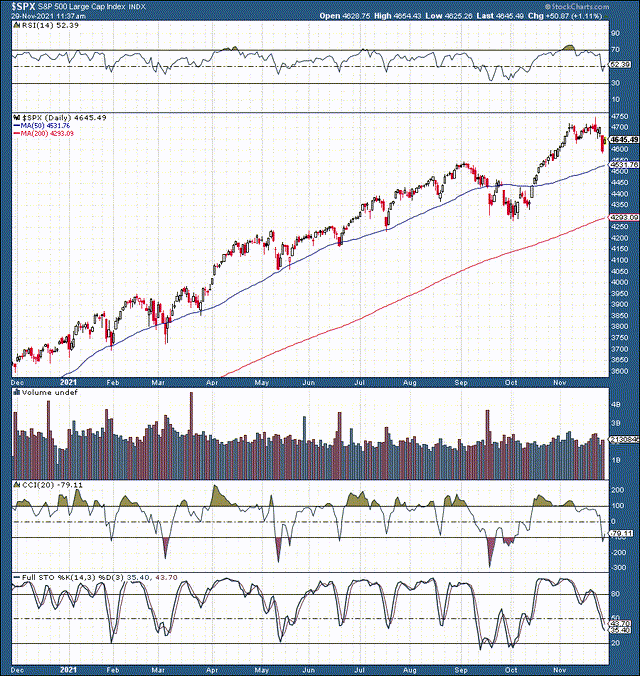
Source: stockcharts.com
Despite the bounce back today, I am not crazy about the technical image here. The S&P 500 got quite overbought recently. We saw the Relative Strength Index ("RSI") hit around 75. However, despite making a new all-time high ("ATH") at 4,750 in recent days, the RSI didn't even break 70. This dynamic implies that technical momentum is worsening and may turn even more negative soon.
The market struggled around 4,700-4,750 resistance, and there could be limited upside potential from here. If the S&P 500 recovers here, we may see a near-term top materialize at about 4,800-5,000 by around year-end/early 2022. However, if we see the S&P 500 heads south, it could break 4,600 support, and stocks could go much lower. In a worst-case scenario, we could see a break below 4,500, in which case we could see 4,300, 4,000, or even 3,800 support materialize before "the correction" comes to an end.
Omicron: The New Variant
Omicron, sounds ominous right? Well, the WHO is concerned. The significant number of mutations could make the Omicron variant more likely to reinfect people. Additionally, mutations in this strain could cause the virus to be even more transmissible than the highly contagious Delta variant. Perhaps most concerning is that due to the numerous modifications to the binding spike protein, Omicron could be resistant to current coronavirus vaccines.
However, the Omicron is just beginning to spread outside of South Africa. Yet, things are already getting a lot worse in many countries around the world. For instance, Germany has seen its coronavirus cases skyrocket recently. The highly vaccinated country has been registering tens of thousands of new cases each day lately. The number even ran up to around 80,000 new cases in a single day recently, and unfortunately, the country is registering hundreds of deaths each day now.
Moreover, it's not only Germany. Things are bad all over Europe. France, the U.K., Poland, and other European countries are registering some of the highest coronavirus readings since the pandemic's start. In fact, things are getting so bad that Germany and other European countries are considering instituting more full lockdowns coupled with mandatory vaccines.
Germany's neighbor Austria has already imposed a complete lockdown, and mandatory vaccines for its citizens and other countries will likely follow as we advance. Why is this happening in one of the most heavily vaccinated areas of the world? Well, people are letting their guards down, pockets of the population remain unvaccinated, and many people have declining protection from vaccines they received last fall and winter.
It appears that the COVID-19 shot may turn into an annual affair, much like the flu vaccine. However, the problem is that the coronavirus is much more detrimental to economic stability and growth. After all, increased restrictions and more lockdowns should cause European and other economies to slow more substantially. Regrettably, this coronavirus-driven slowdown is occurring with the Fed taper about to begin.
The Fed Taper Is Coming
The Fed taper is coming soon, and rate hikes should come shortly after. The Fed's been buying about $120 billion worth of bonds and mortgage-backed securities each month to keep the economy from stalling out during the COVID-19 crisis. Now the central bank is about to take the easy money punch bowl away. While the taper should be "gradual," Goldman Sachs (GS) and others expect the Fed to decrease bond purchases to just $30 billion after January and wind down completely by mid-March.
The taper is only half the problem, as rate hikes are expected around this time as well. There is now a 62% probability that the benchmark rate will be at 25-50 basis points or higher by early summer 2022. GDP in the U.S. and other notable economies is already slowing. We saw U.S. GDP figures come in at just 2.1% for Q3. Germany put up a 1.7% print for the same quarter, and other major economies are also registering slower than anticipated growth.
The Fed taper coupled with the anticipated higher interest rate environment should continue to pressure economic growth from now on. If the world's most significant economies are showing difficulty expanding now, tighter monetary policy will not enable growth to accelerate. Now, whether the Fed chooses to raise rates aggressively remains to be seen. However, the critical factor right now is that the market expects the Fed to act soon. Unfortunately, it does not appear that the stock market has priced in the Fed's plans, and stocks are at risk of being repriced substantially lower here.
Valuations: Stocks Have Gone Wild
Now, we've seen some sharp run-ups lately. Some prominent names that come to mind include Nvidia (NVDA), Tesla (TSLA), Advanced Micro Devices (AMD), and others.
Tesla: 3-Year Chart
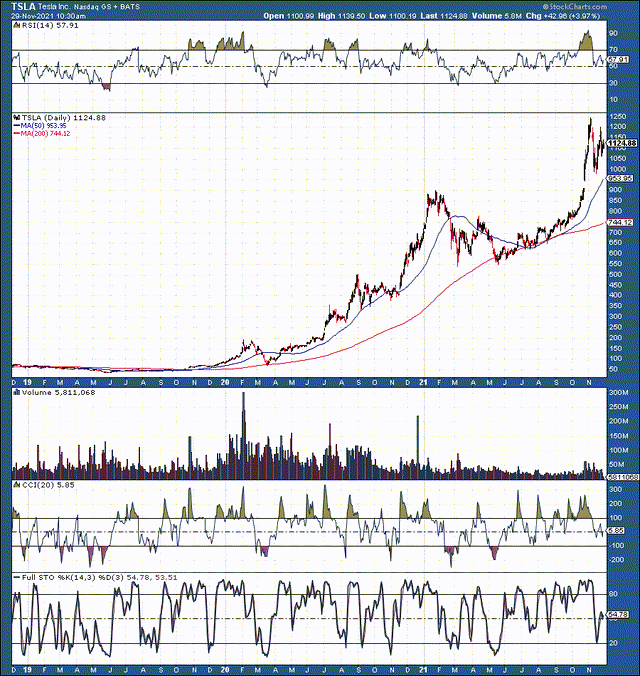
Source: stockcharts.com
I don't want to pick on Tesla, as this company remains one of my favorite and best investments in recent years. However, exploding by about 20x since 2019, its valuation is pretty high right now. With a trillion-dollar market cap and a forward P/E ratio of about 180, I believe there is probably more risk to the downside than further upside in the near term here.
Nvidia: 3-Year Chart
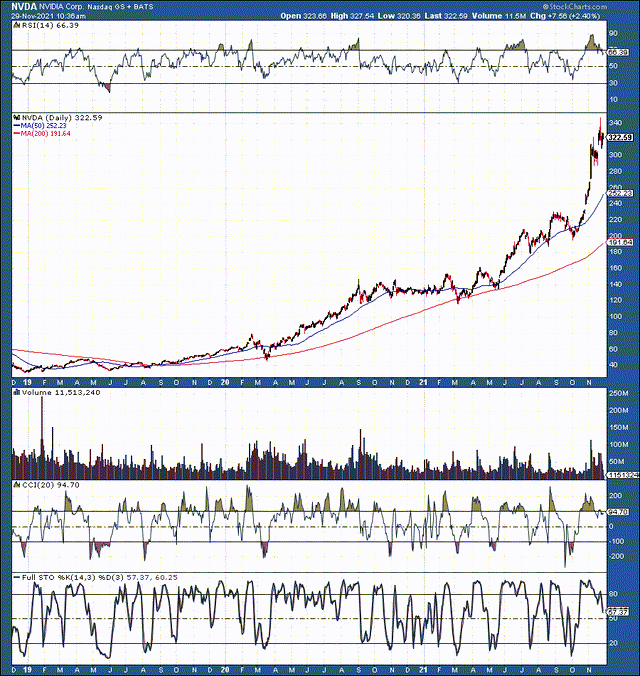
Source: stockcharts.com
Nvidia, another market darling right now, has appreciated by about 10x since its low point in 2019. Now, Nvidia is approaching a market cap of $800 billion while trading at around 30 times this year's projected sales forecasts.
Advanced Micro Devices: 3-Year Chart
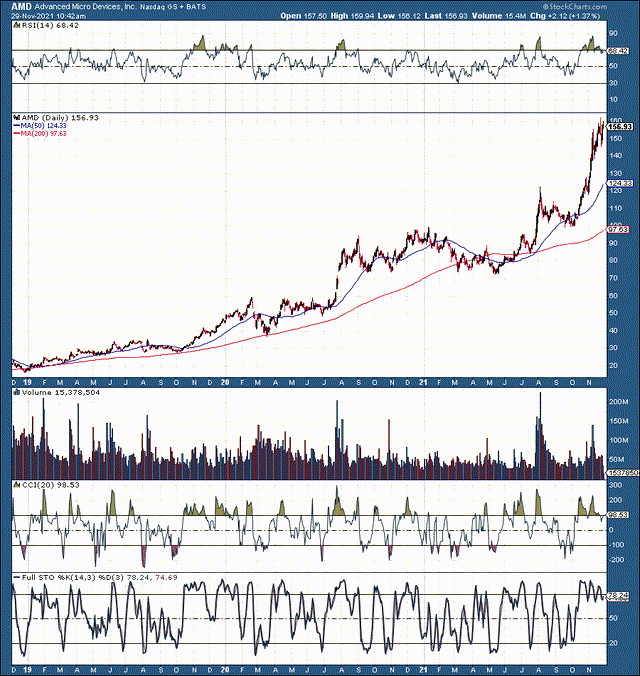
Source: stockcharts.com
AMD, the most conservative of the three, has also appreciated by about 10x from its 2019 low level. Now the company trades at a nose bleeding high 60 times this year's earnings estimates.
These are remarkably high metrics, and it's not only about Tesla, AMD, and Nvidia. I owned Tesla up until very recently, and I still own AMD now (with hedges). However, I bring these names because their significantly elevated valuations illustrate the highly overbought state of the broader market right now.
Shiller P/E Ratio
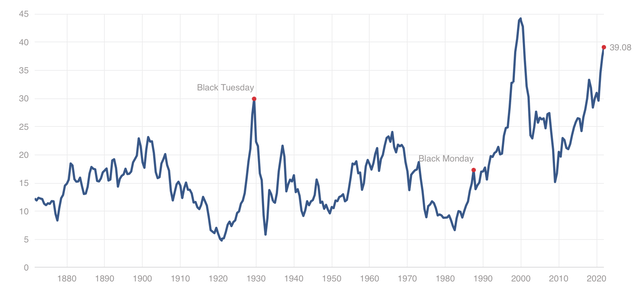
Source: multpl.com
Look at the Shiller P/E ratio here. We're approaching dot-com bubble level highs, and this is occurring while the coronavirus continues to weigh on growth, the taper is in motion, and the technical image degrades. This dynamic could be a recipe for disaster, and equities could get repriced sharply lower in the near term.
S&P 500 Components
Let's look at some of the most significant S&P 500 components. The most prominent member of the S&P 500 right now is Microsoft (MSFT). Now, Microsoft accounts for about 6.35% of the index's weight. Microsoft trades at about 37 times forward consensus EPS figures. This valuation is highly stretched. Microsoft was typically an 8-12 P/E ratio company for most of the last two decades, then it was 15, and now it's 37 all of a sudden. Moreover, its price to sales valuation was about 2-3, and now, Microsoft is approaching 15. This type of P/S valuation is something you may expect to see on a high risk/high reward small-cap growth stock, but Microsoft?
Now, let's look at Apple, the second-largest component of the S&P 500 at about 6.32% weight. Apple is trading at over seven times sales, also around its highest level in the last two decades. Moreover, Apple is approaching a 30 P/E multiple, which is remarkably high for a company with questionable growth prospects ahead.
The S&P 500 is dominated by mega high-cap tech. The index's top seven holdings are all the mega-cap tech stocks that account for around 28% of the index's total weight. Alarmingly, these companies and many others are trading at abnormally high valuations that could get repriced at any moment.
So, what would happen to the S&P 500 and other major stock market averages if the big tech names and other frothy market-leading companies corrected? Well, we could see a severe market meltdown, and a correction of 20% is not out of the question in my view.
To be clear, a 20% correction from the recent top would drag the S&P 500 down to precisely the 3,800 support level. However, even a milder 15% drop would bring the S&P 500 down to around 4,000, causing massive pain and portfolio damage in the process.
Don't Be The One Left Standing When The Music Stops
I know people say, "stay invested at all times, you can't time the market, a correction could come at any time, etc." However, my question is, why would you want to stay fully invested in stocks and experience a significant drawdown if you could avoid it? Don't you want to avoid taking unnecessary losses?
After all, a substantial decline in the stock market could wipe out gains that took years to achieve. Worse even, if you are using margin, you are not only at risk of giving up profits, but you could potentially lose your principal investment, or in a worse case, end up owing your broker money.
With investing, you always have a choice. For starters, you can choose to mitigate risk, enabling you to decrease your potential losses. You can choose to rotate some capital away from the ultra-high multiple, high-flying stocks. In turn, you can diversify into value, defensives, gold miners, and other less vulnerable segments.
Moreover, you can raise cash and shore up your dry powder reserves. Perhaps most importantly, you can hedge. Effective hedging is a powerful way to reduce risk in your portfolio and possibly even make money on the way down. Therefore, you don't need to sell all your stocks and sit on the sidelines. However, when the economic landscape changes, you may want to adjust your investment approach, especially when it looks like a stock market may experience a significant decline.
Disclosure: I/we have a beneficial long position in the shares of AMD either through stock ownership, options, or other derivatives.
Disclaimer: This article expresses solely my ...
more



But doesn't your chart also show that u should buy the dips coz the trend is always up?